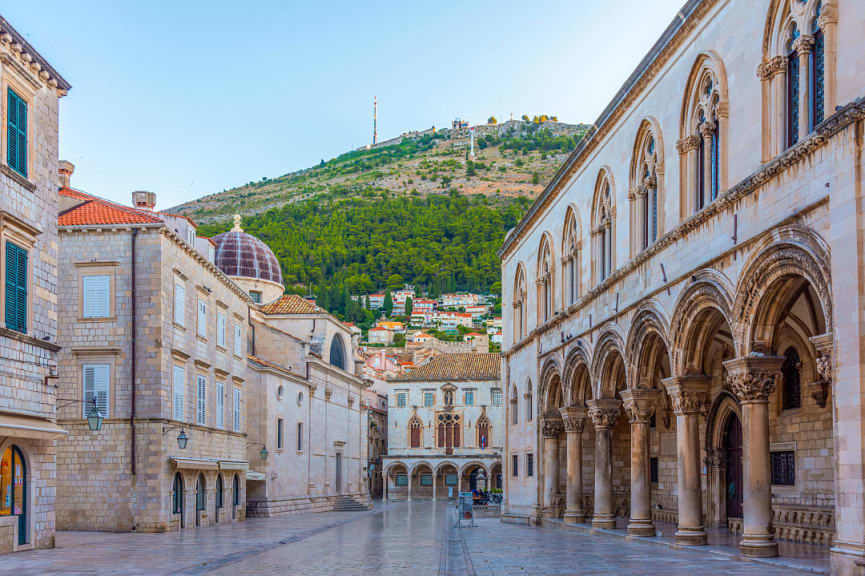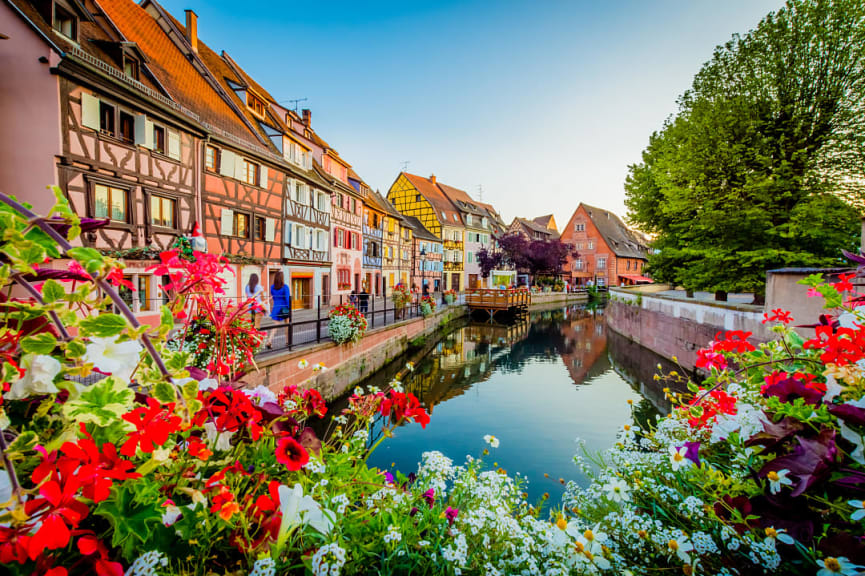Best Time to Visit Europe

Grand canal and Santa Maria della Salute Basilica in Venice, Italy
The best time to visit Europe is typically during spring, March to May, and fall, September to November, as these times offer the benefits of traveling in the shoulder season. Travelers visiting most European countries and their popular regions, cities, towns, or islands in spring and fall can expect cooler temperatures and fewer crowds than in summer.
While we recommend shoulder-season travel for Europe tours, the diverse climates across western, eastern, northern, southern, and central Europe offer conditions that are suitable for different travel experiences. You could enjoy Greek beaches in the summer or Italian Christmas markets in the winter, meander the English countryside in spring, or see the Northern Lights in Iceland in fall. Europe is a year-round destination, depending on how you would like to explore.
In this guide, we share the best times of the year for the top countries and regions, and provide ideas of when to plan your vacation, depending on who you travel with or the experiences you would like to have. From Italy to Iceland, family trips to romantic getaways, discover the best month to visit Europe for your destination and custom trip.
Best Time to Visit Europe’s Top Destinations

Rio Turia fountain in Valencia, Spain
The best time to visit Europe depends on where you would like to go, what you would like to do, and what travel expectations are most important to you.
Summer in the Mediterranean is incredibly popular and temperatures can be overwhelmingly hot, which makes the cooler parts of central and eastern Europe popular alternatives for summer travel. In contrast, winter in northern Europe can be frigid and travelers chasing a snowy Christmas may prefer to visit countries in the south for more manageable temperatures.
Considering the range of climates and conditions travelers can expect across Europe, we have compiled a list of the best times to visit specific countries or places, and you can explore the links below to find out more about the best time to travel to your favorite European destinations.
- High season - May, June, July, August
- Shoulder season - March, April, September, October
- Low season - November, December, January, February
- Learn more: Italy Tours & Vacations • Italy Travel Guide
- High season - July, August
- Shoulder season - March, April, May, June, September, October
- Low season - November, December, January, February
- Learn more: Greece Tours & Vacations • Greece Travel Guide
- High season - June, July, August
- Shoulder season - March, April, May, September, October, November
- Low season - December, January, February
- Learn more: Spain Tours & Vacations • Spain Travel Guide
- High season - June, July, August
- Shoulder season - April, May, September, October, November
- Low season - December, January, February, March
- Learn more: Portugal Tours & Vacations • Portugal Travel Guide
- High season - May, June, July
- Shoulder season - March, April, August, September, October
- Low season - November, December, January, February
- Learn more: France Tours & Vacations • France Travel Guide
- High season - June, July, August
- Shoulder season - May, September, October
- Low season - November, December, January, February, March, April
- Learn more: Croatia Tours & Vacations • Croatia Travel Guide
Best Time to Visit the Mediterranean
- High season - June, July, August
- Shoulder season - April, May, September, October, November
- Low season - December, January, February, March
- Learn more: Mediterranean Tours & Vacations • Mediterranean Travel Guide
- High season - July, August
- Shoulder season - May, June, September, October
- Low season - November, December, January, February, March, April
- Learn more: UK Tours & Vacations • UK Travel Guide
- High season - June, July, August
- Shoulder season - May, September, October
- Low season - November, December, January, February, March, April
- Learn more: Iceland Tours & Vacations • Iceland Travel Guide
Best Time for Great Weather

Santorini Island in Greece
Best Months: May • June • July • August • September
The best time to travel to Europe for great weather depends on where you are going as, for example, southern European countries experience pleasant weather from May through September, while those in the north experience the warmest weather in July and August.
May through September is the best window for warm weather and clear skies in most of the best places to visit in Europe, from Mediterranean countries like Italy, Greece, Spain, and Portugal to central European countries like Germany and Austria.
Best Time for Beaches and Surfing

Viejo Reyes Beach in Fuerteventura, Spain
Best Months: June • July • August • September • October
Whether visiting Europe’s best beaches as a family or couple, or planning a surfing trip to Portugal with friends, the best time to enjoy sunshine and great swells on European shores is from June through October.
The summer months of June, July, and August offer warm weather and clear skies perfect for soaking up the sunshine on the best beaches in the Mediterranean or discovering secret shores along Portugal’s Azores Islands. The start of fall, in September moving into October, brings the North Atlantic swells to France, Spain, and Portugal’s best surfing spots.
Best Time for Sightseeing

Vernazza on Cinque Terre, Italy
Best Months: March • April • May • September • October • November
The best time of the year to visit Europe for sightseeing, whether touring the Colosseum in Rome or exploring the medieval castles in the UK, is during the shoulder season months of March through May and September through November.
Most places in Europe are quieter in spring and fall, and this makes exploring landmarks, historic sites, art galleries, monuments, and more far easier than in the busy summer travel season. For this reason, you can enjoy a more comfortable tour of Europe’s best cities for art lovers, history buffs, and casual sightseeing.
Best Time for Active Adventures

Seljalandsfoss Waterfall in Iceland
Best Months: March • April • May • June • July • August
The best time for enjoying the beautiful European outdoors on active adventures is in spring, from March through May, and in summer, from June through August. During these times of the year, travelers can expect more clear days, providing the best conditions for partaking in outdoor experiences.
In spring and summer, you can visit the best places for hiking in Europe, including the towering peaks of Italy’s Dolomites and the surreal shores of Santorini in Greece, or cycle remarkable routes at the best cycling destinations in Europe. Bear in mind that summer can bring high temperatures to most parts of the continent, specifically the Mediterranean and central Europe. In contrast, northern Europe’s temperatures are far more forgiving in summer for active trips.
Best Time for Food & Wine

Grilled octopus served at a restaurant in Porto, Portugal
Best Months: September • October • November • December • January • February
Travelers can enjoy the best food and wine in Europe at any time of the year, though wine-tasting pairings are best when they fall during or just after the harvest season, with most related festivals and celebrations taking place between September and October, and post-harvest tastings happening in January and February.
Beyond enjoying delicious European dishes with wine, you can partake in food tours throughout the year. Each season in each country offers unique seasonal and regional specialties, meaning you can always try something new, no matter when you visit. The winter months of December through February are also fantastic times to consider, as you can experience a taste of Christmas culinary culture in the best places in Europe for food and wine.
Learn more: Food & Wine Travel Guide
Best Time for Natural Beauty & Gardens

Villa d'Este on Lake Como, Italy
Best Months: March • April • May • September • October • November
The best time to view Europe’s breathtaking landscapes and wander the spectacular gardens across the continent is during spring, March to May, and fall, September to November, when the flowers bloom or the colors shift with the seasons.
Spring and fall offer relatively comfortable temperatures in most destinations in Europe, whether looking to visit the breathtaking national parks in Italy or eager to explore Portugal, France, or Croatia under clear skies and within mild temperatures that create the perfect conditions for wandering outdoors in national parks or meandering the manicured gardens.
Best Time to Avoid the Crowds

Pred Dvorom street "Ulica" in Dubrovnik, Croatia
Best Months: March • April • May • September • October • November
The best time to avoid the crowds in most parts of Europe is in spring, March to May, and fall, September to November. That said, this can differ slightly from country to country. For example, Italy is incredibly popular in April and May, as like-minded travelers book their trips for spring instead of the peak summer season. On the other hand, travelers visiting northern Europe to avoid the crowds may not choose to go in November as the cold temperatures arrive for winter.
Whether escaping the crowds at Greece’s hidden gems or visiting eastern Europe in the shoulder season, the best time for your specific trip outside of the tourist seasons ultimately depends on where you decide to go and the temperatures you are willing to manage.
Best Time for Families with Children

Family in Paris, France
Best Months: March • April • May • June
Whether training like gladiators in Rome’s Colosseum or rising above the city skyline on the London Eye, explore the best cities to visit in Europe with children during the somewhat quieter months of spring, March to May, or the start of summer, June.
Spring and early summer offer the best weather for outdoor activities and many of the top experiences to have in Europe as a family. During this time of the year, you can snorkel with colorful marine life, enjoy a scoop of gelato on the Italian coastline, or navigate the overgrown forests of Croatia’s national parks when the sun is shining and the skies are clear.
Learn more: European Family Vacations & Tours
Best Time for Couples or Honeymooners

Couple in Santorini at sunset in Greece
Best Months: December • January • February • March • April • May
Winter and spring are two of the best seasons for couples or honeymooners visiting Europe as you can cuddle up around the fire with hot cocoa on an Italian Christmas tour or see the spring flowers bloom across the French countryside from one chateau to the next, two of the best countries to visit in Europe as a couple.
When planning a romantic escape in Europe in winter or spring, remember that the temperatures vary from one region to another. For example, we would highly recommend spring if you plan on traveling to northern Europe, unless you specifically want to see the Christmas lights or ski the alpine slopes in winter. The decision ultimately comes down to which of the most romantic things to do in Europe are on your travel wishlist and where you decide to go.
Learn more: Romantic Europe Tours for Couples • Europe Honeymoon Packages
Best Time for Seniors

Dunrobin Castle in Scotland
Best Months: March • April • May • September • October • November
March through May and September through November, spring and fall respectively, offer the perfect weather conditions for a comfortable seniors tour in most parts of Europe. While northern European countries can start to experience freezing temperatures towards the end of fall, southern Europe offers an alternative, with remarkable fall colors.
On the other hand, spring is stunning throughout Europe’s best places to visit for senior travelers, while the fewer crowds towards the earlier months of spring mean seniors can enjoy first-class amenities and services without having to navigate overwhelming summer crowds.
Learn more: European Tours & Vacations for Seniors
What to Expect on a Spring & Summer Europe Vacation

Colorful houses in Colmar, France
Spring Months: March • April • May
Summer Months: June • July • August
Many travelers regard spring and summer as the best times to visit Europe because the temperatures are preferable across northern, southern, western, eastern, and central Europe. And while there are variations in highs and lows from one country to the next, you should enjoy a level of consistency, like clear skies and warm sunshine.
Summer travelers also take advantage of longer days, creating more room for travel experiences within a single day. This is especially advantageous when visiting northern European countries that are greatly affected by the change in daylight hours between the seasons.
Learn more: Spring Vacation Ideas • Summer Vacation Ideas
What to Expect on a Fall & Winter Europe Vacation

Vineyard in Alentejo, Portugal
Fall Months: September • October • November
Winter Months: December • January • February
Fall and winter, while far colder than spring and summer, offer new opportunities for travelers who brave the cooler temperatures. In some European countries, like those in the Mediterranean, fall is very manageable and winter, though cold, is less challenging than in other parts of Europe, for example, the northern countries.
And while the temperatures drop and daylight hours are shorter, you can take advantage of the many benefits of Europe in fall and winter. Snow veils large parts of the continent in December, providing the perfect conditions for a classic and atmospheric Christmas in Europe’s best holiday destinations, while the changing colors in fall create dramatic backdrops of burnt orange for cinematic travel photography.
Learn more: Fall Vacation Ideas • Winter Vacation Ideas
Book for the Best Time to Visit Europe

View of Olvera town in Cadiz, Spain
Whether planning to spend winter in Italy at bubbly Christmas markets or keen to island hop between the Greek islands when the summer sunshine is at its peak, our custom European tours and vacations share inspiration for your preferred time to visit Europe.
Considering the extent of options available to you when deciding where to go and what to do, let our Europe travel guide help get you started with travel advice and expert tips for your Europe trip.
Life-Enriching Travel Designed Just for You
- 1
Trips curated by the world’s top destination experts
- 2
Concierge-level service leading up to and during your trip
- 3
Unique, exclusive experiences and insider access





